Croatia Through the Eyes of a Digital Nomad: Give Bees a Chance
September 22, 2020 - How does Croatia look through the eyes of a digital nomad? TCN is delighted to welcome new columnist Cyndie Burkhardt, who will be sharing her exepriences as a digtal nomad in Croatia. And where better to start - give bees a chance from the idyllic island of Šolta.
Still being a newbie in Split (I’ve lived here since March 1), I’m keen to see as much of the Dalmatian coast as possible. This time of year the islands dotting the Adriatic Sea are calling me. I’ve come to learn that many of them are known for something among Croatia’s vast natural resources and specialties. Šolta has come up several in conversations extolling its reputation for honey. That was all I needed to hear—indigenous food and Croatian culture. I was determined to visit.
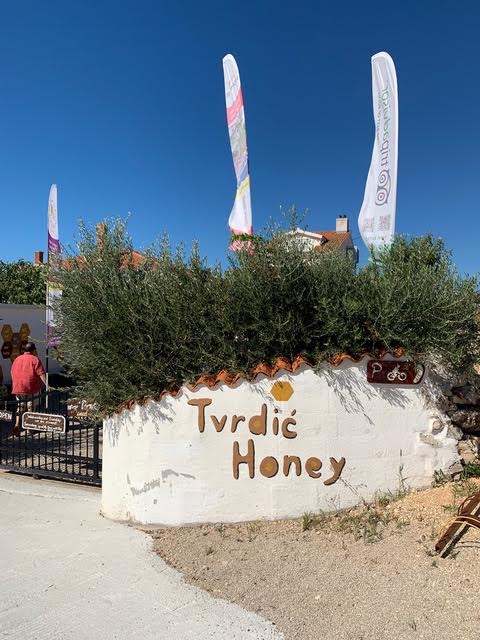
Tvrdić Honey farm
I buy local honey in every country I visit. The most intriguing so far was in Malaysia, where I was introduced to a rare treetop variety. Meaning, industrious “honey hunters,” as they’re called, literally climb to the very top of very tall trees to extract it from a hive. Malaysians claim it has exceptional nutritional value. Taste-wise, it was divine. I view honey similar to wine varietals—environment, land, and weather make it unique. I enjoy experimenting with different flavors in my morning tea, itself from a selection of loose-leaf varietals. Plus, I feel like I’m doing my body a favor. Local honey is supposed to be good for you, possessing vital nutrients that support the immune system and antioxidant benefits.
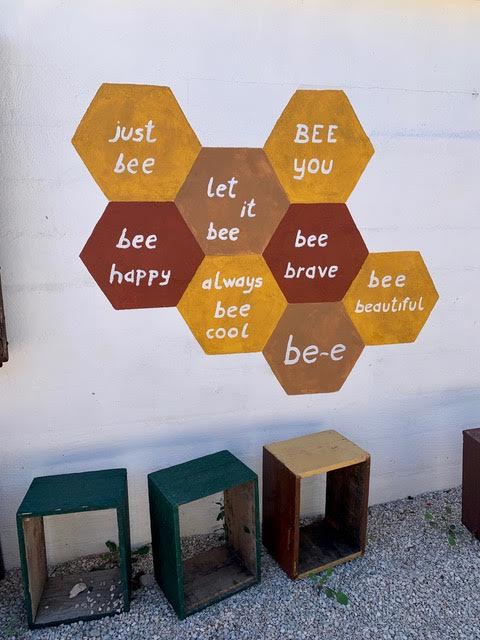
Positive messages reflect family philosophy
I found Tomislav Tvrdić, of Tvrdić Honey, and signed up for his “Give Bees a Chance” tour. I took an early boat from Split and met his father Goran straight away. The minute I saw his warm smile I knew I was in good hands. Goran is a 3rd generation beekeeper, making Tomislav the 4th. His grandfather started the bee farm in 1934 and his father kept it going. Where those two dabbled with it outside of their regular jobs, Goran took it on full-time. He’s clearly passionate about “the animals,” as he calls the bees.
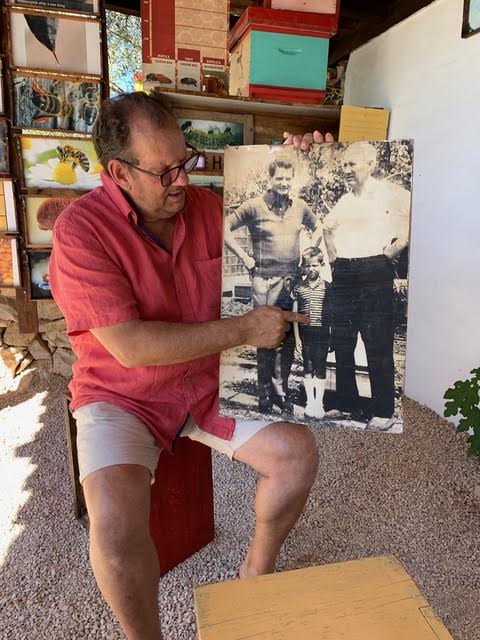
Three generations of Tvrdić family; Goran center
We arrived at the farm he went straightaway to “the store,” a huge fig tree that I could see towering above the roof. When he came bounding down the ladder, he extended his hand with a basket full of the ripe fruit. We chowed down right there, along with his wife and Tomislav, while chatting about bees and the family’s history.

Worker bees in a honeycomb
By the time we moved into the learning center, a modest setup of chairs and props across the yard, we’d established a comfortable conversation. Goran told me about the six products that bees produce. Who knew there were so many? Their bodies emit poison (think bee stings), royal jelly (a top-of-the-line secretion that worker bees deposit directly into the queen as her premium food source), and propolis, a natural antibacterial. Bees also make honey, pollen, and wax.
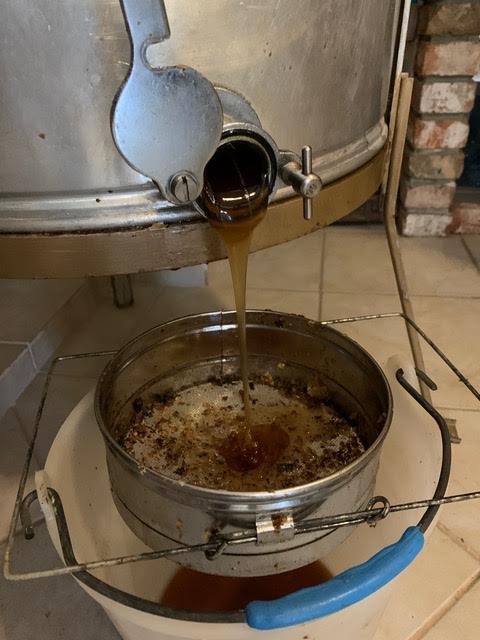
Fresh honey spun from a comb
Goran is a purist and stores pollen in the freezer for maximum freshness and effectiveness. He also warned me to check the temperature of my tea before adding honey. It needs to be under 105°F (40.5°C). Violate these rules and you’ll kill the product benefits, making it pointless to use them. To him and many others, bee products are medicine, especially Manuka honey from New Zealand. That one is used by doctors for antiviral, anti-inflammatory, and antioxidant properties. At prices up to €200 per jar (roughly $237), you would hope that claims of wound healing, cold and flu prevention, and curing oral ailments are accurate.

Community board with photos, notes, and kid’s drawings
I’m not a fan of bee pollen. The stuff I’ve eaten was crunchy and pungent, limiting its use to blended foods to make it palatable. Ok for a smoothie, but not my morning tea. Goran fetched a container from the freezer. This pollen was soft and delicious. It nearly melted in my hand and each tiny nugget had a rich, complex taste. Our fingers stained slightly yellow from pinching little bites, similar to the color of turmeric. Mind blown. This, I could eat.
After discussing bee sex and the lifespans of the queen, drones, and workers, Goran and I went into the shop to see a colony at work and taste gooey honey right off the comb.
I noticed a creamy looking product that turned out to be a blend of pollen and honey. In that combination pollen doesn’t need to be frozen. Great, I needed to try it! Šolta’s rosemary grows everywhere and naturally lends itself to ružmarin domaći šoltanski med (rosemary homemade Šolta honey), one of Tvrdić’s main products along with kadulja (sage) honey. Yum. My backpack filled up quickly.

Visitors from around the world send honey from their countries
Inside Tvrdić’s part shop, part museum, I gazed at world maps and a massive, international honey collection while chatting away. I felt a nice connection with Goran and his family and I completely lost track of time. I prepared to leave and apologized for keeping him well past our scheduled tour as the clock ticked toward 2 hours. Oops!
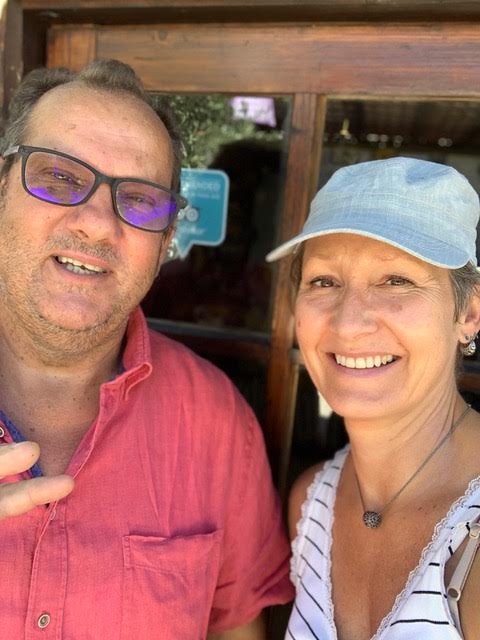
Goran Tvrdić and the author
He seemed completely relaxed and ok with it. For him, life is about doing what you’re passionate about, meeting people, and authentic local experiences. The many cards and personal notes throughout the shop, including drawings from kids and gifts that people have sent from around the world, prove that Goran is onto something. In a final gesture, he sent me off with a container of fresh figs. Could this guy be any nicer? This must be the famous Croatian hospitality I’ve read about.
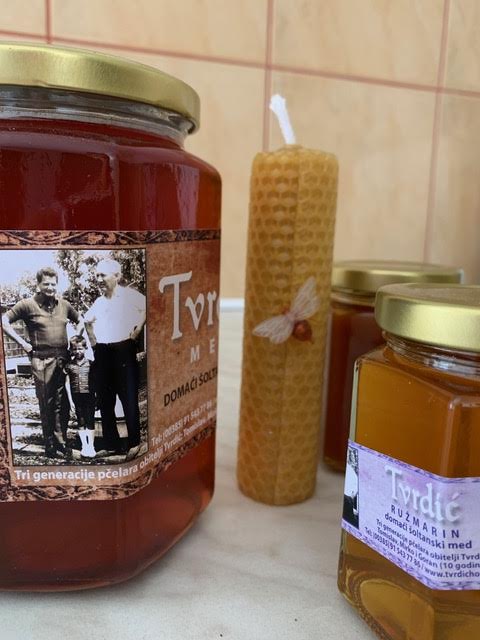
Tvrdić Honey products
When Goran first picked me up at the ferry, he asked about my plans for the day. I mentioned swimming and then lunch after our tour. He dropped me off at a small inlet with clear blue water and pointed out a couple of dining spots. When it was time to eat I headed to Pasarela and settled in for a plate of crni rizot, the traditional Croatian dish I’ve been wanting to try since I arrived here six months ago. It was absolutely delicious. I washed it down with my new favorite drink, Pelinkovać and tonic.
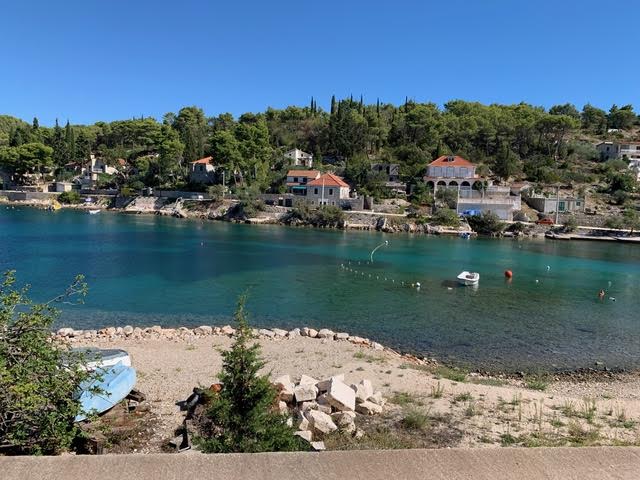
Swimming inlet
I wore a silly grin on my face for the rest of the afternoon, touched by the kindness of strangers and soaking up my perfect Croatian day.
Learn more about Tvrdić Honey and schedule a tour.
Story and photographs ©2020, Cyndie Burkhardt. www.photo-diaries.com.
You can follow the latest from Cyndie's column, Croatia Through the Eyes of a Digital Nomad here.
For the latest news about digital nomads in Croatia, including that sought-after nomad visa, check out the dedicated TCN digital nomad news section.
Green List Calls for Stepping Up Control of Honey
ZAGREB, November 4, 2019 - The Green List on Sunday sent an open letter to Agriculture Minister Marija Vučković calling on authorities to step up control on honey on the domestic market, as this non-parliamentary party believes that there are some fraudulent activities considering the quality of this food to the detriment of consumers.
The Green List insists on the correct labelling so that consumers can know the origin of honey on the market.
It also insists on the immediate ban on glyphosate and other products for agricultural weed control which affect bees.
The list says that Croatia has ecological, climate and other comparative advantages for the honey production that can meet the domestic needs as well as demand from abroad.
Croatian bee-keepers are definitely ready for such production, with the support of the state authorities and consumers, reads the open letter.
The authorities should perform large-scale controls on a more frequent basis and consumers should be aware that they cannot buy authentic product at the price lower than 50 kuna per kilo.
The list supports the nation-wide action about Croatian primary school pupils being taught about the importance of honey in their food. As part of the campaign, each first grader is to get a jar of Croatian honey produced by local beekeepers.
The list says that although the imports in the first half of 2019 dropped by 57% on the year, the agriculture ministry is supposed to take some more actions to support local 10,000 beekeepers and honey consumers.
More food news can be found in the Lifestyle section.
Medena Rakija, Bee Crisis, Natural Goodness: Magical OPG Franic near Varazdin
September 8, 2019 - We are delighted to welcome Elizabeth Wilson to TCN, especially with a great first article on one of the treasures of continental Croatia, the honey goodness of OPG Franic. Welcome, Number 139! If you would like to write about the Croatia, Montenegro or Slovenia where you are, please contact us on This email address is being protected from spambots. You need JavaScript enabled to view it.
What is the future of Croatia? That question can attract infinite speculation, but according to Mirko Franić, a Croatian beekeeper with almost four decades of experience, it can’t be answered without looking first to the bees. “What happens to the bees will happen to us."
His business, OPG Franić, has provided a living for his family since the late 80s. He is a registered instructor of apiculture, and a strong proponent of Croatian tradition and sustainable agriculture. Born and raised in Daruvar, and a longtime resident of Varaždin, this Slavonian is a familiar face for many people throughout Croatia. For decades now, he has sold his honey products at fairs, festivals and at tourist destinations throughout the country.
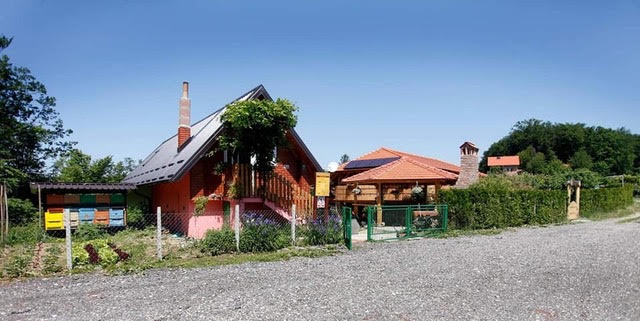
(The house that bees built: OPG Franić started in a small shack near their present location in Cerje Tužno, but with hard work and attention to the market for honey products, they have expanded their bee farm to include a local retreat and a tourist destination for people interested in the world of bees.)
“This has been a catastrophic year for bees, unlike any I have ever seen,” he warns. “Not just in Croatia, but worldwide.” Increasingly unpredictable and unstable weather wreaks havoc on the cycles of seasonal blooms that bees depend on. The health of the bees is in turn absolutely essential for the food supply we rely on. The increasing use of pesticides and herbicides encroach even in isolated farms. “If local bees can’t thrive,” Mr. Franić says, “neither can local agriculture.”

A similar disrupted cycle occurs in the marketplace: it’s difficult to sustain the scale of production necessary to make a living from honey, yet the market doesn’t favor small-scale local family farms. Unfair advantages of international trade add further obstacles to succeeding as a beekeeper. “Local honey is always the best option for consumers, and of course it’s important to support our local ecosystem, yet the European Union is a net importer of honey. We can buy all the honey from China we want, but without bees, without our bees, we’ll go hungry. This year,” he adds, “I worry that the bees won’t have enough even for themselves. We have to support them.”

(“In forty years of beekeeping, I’ve never seen such a difficult season for bees,” warns Mirko Franić. The weather is ever more unstable and unpredictable. Why does that matter? “The future of bees will be the future of all of us.”)
But even though bees are recognized for the essential role they play in the circle of life, and although their products (including honey, propolis, royal jelly) provide both food and medicine for people, the situation gets worse every year. Many people push back against this trend: there’s an increasing interest in sustainable agriculture and promoting harmonious relationships with the natural world. Varaždin County, for example, features a variety of ecotourist destinations to visitors, and the Franić family farm is one along the route.

(Passing on knowledge of bees and awareness of their important role is an important part of the values of OPG Franić. Snježana Franić, from her year-round stand in Varaždin, shows schoolchildren an example of honeycomb, so they can see how bees build their homes and where they store their honey.)
“People eventually will return to many of the traditional ways of life, they won’t have a choice.” Mr. Franić predicts. “In the meantime, it’s important to protect the sources of our sustenance and to increase people’s awareness of the natural world. It is our responsibility to pass traditional knowledge to future generations.”
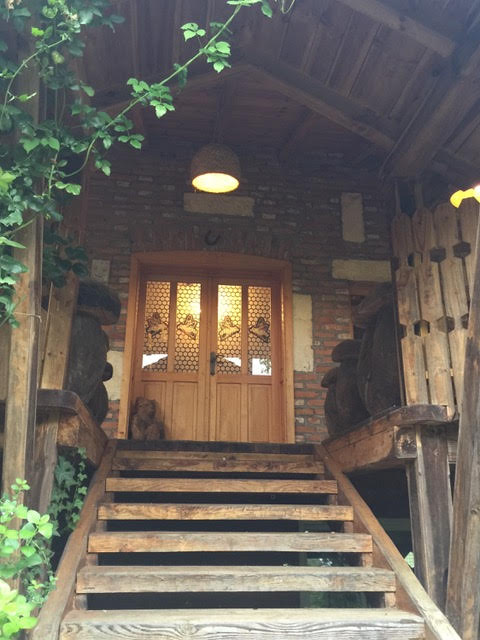
(Through these doors visitors can enter into the life of beekeeping and sample their products.)
With a bit of entrepreneurial ingenuity, Mirko Franić has found a unique way forward, entwining another Croatian tradition with the tradition of the family farm: he makes rakija from his honey. Šlivovica, of course, which is poorly translated into plum brandy, is one of the most basic rituals of Croatian culture, and one of the first traditions that visitors discover in Croatia. People then hear about medica, which is šlivovica with honey added.
“There’s a big difference between medica and medena rakija,” Mirko is careful to point out. “Rakija is usually made with plums or other fruit. It has a strong, sharp taste.”
Medena rakija, on the other hand, is a liquor made straight from honey, and only from honey. It retains the beautiful gold color and sweet smooth taste. The alcohol content ranges between 20 and 30%, depending on the batch, and consistently exceeds all standards for quality. Mr. Franić owns the copyright for his recipe, and Medena Rakija is the brand name of the leading product of O.P.G. Franić. It therefore has the special status of being both a unique and original product, and at the same time a part of a long and proud tradition of Croatian spirits.
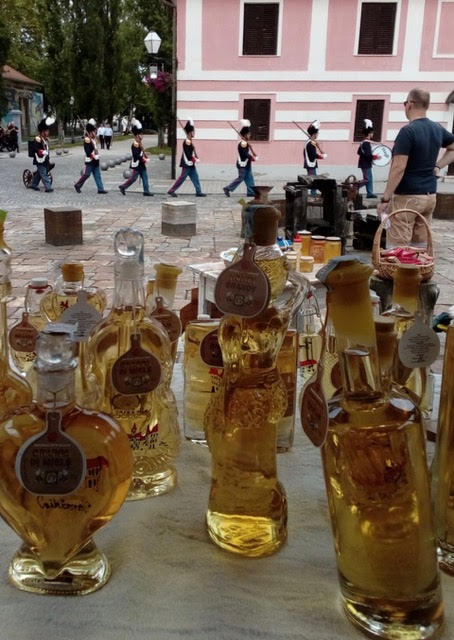
(The Franić stand on the Trg Tradicialna Obrta, in the Old Town, is just one of many Varaždin tourist offerings, selling its locally produced honey products in the shadow of the Ursuline convent.)
As of 2008, the family expanded the farm to include a beautiful retreat in the small village of Cerje Tužno, 14k outside of Varaždin, near the border with Slovenia. There he keeps his hives, extracts the honey, and makes the rakija. The grounds are groomed so that there is always something in bloom to interest the bees. There is also a lovely chalet designed to welcome both locals and newcomers to Croatia, able to accommodate tour buses or to rent for private parties and special events.
His greatest pride is in knowing he has offered consistent excellence while honoring a sense of responsibility to the natural world. “I will never compromise on the quality,” says Mr. Franić, “and my customers know that.” As proof, he passes his hand over an impressive display of medals, plaques and prizes. Through the years, the business he created has gathered more than 300 awards for the quality of his honey, honey brandy and honey products, including another novelty for many people: honey vinegar.
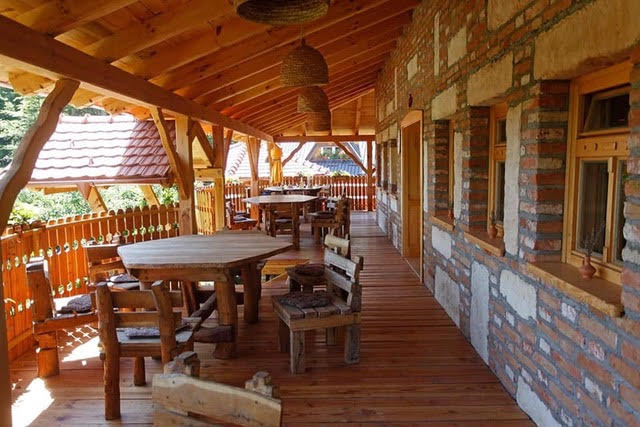
(Groups of up to 80 people are welcome to visit the bee farm and sample the honey products, and to enjoy peace, quiet, and some good company at the outdoor terrace and barbecue.)
He first started the business with his late wife, Slavica, and it is now managed by his daughter, Snježana, who is a familiar sight at their permanent stand on the Trg Tradicialna Obrta in Varaždin. Their rakija is sold in a diverse assortment of bottles and when the sun shines on the booth, or at dusk when she switches the overhead light on, they glow with a golden light. She paints the bottles by hand with street scenes of Varaždin and other images. School children who pass through the square on class outings buy miniature jars of honey, which she personalizes for them with a practiced hand. She has honeycomb always within reach which she is happy to show them, providing a mini-lesson on one of the most fascinating processes in the natural world. Travelers buy these honey products as charming souvenirs of Croatian-made products. And so OPG Franić interweaves yet another essential Croatian tradition: tourism.
Snježana shares her father’s absolute confidence in the quality of their products. “We always offer a taste of rakija to people who visit our booth,” she says as she draws a sample from the thermos behind the counter. “All they have to do is try it. When people taste it, they want it. They realize immediately it is something special.” They have a solid base of return customers throughout Croatia, and many from abroad who have been known to travel far out of their way just to replenish their supply of Medena Rakija.
Although Mr. Franić has found a way to make the most of his honey and create a solid business, the future, he emphasizes, is not secure. “It’s not a question of where people will buy their honey for tea, or propolis for mosquito bites. What happens to the bees will happen to us. The balance of nature is at stake. This is a question of survival.”
You can learn more about OPG Franic and watch their promo video on the official website.
All First-Grade Students to Receive Special Jars of Honey
The honey will be served in “the national honey jars”.
Croatian and EU Market Full of “Fake” Honey
Due to unfair competition from China, Croatian producers have a hard time reaching consumers.


